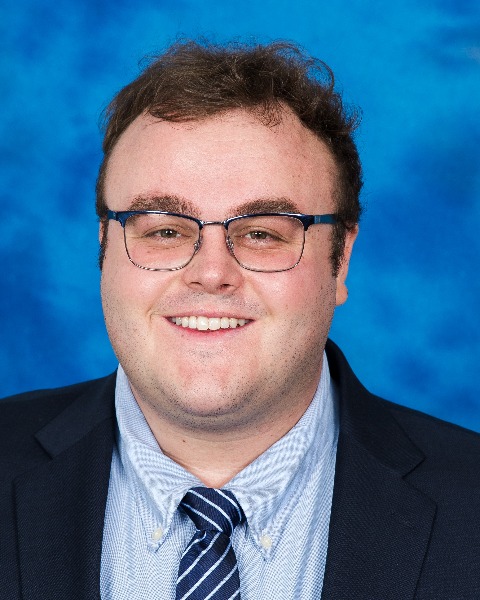Monday Poster Session
Category: Esophagus
P2818 - Recurrent Squamous Cell Carcinoma Presenting as Refractory Esophageal Stricture
Monday, October 27, 2025
10:30 AM - 4:00 PM PDT
Location: Exhibit Hall

Micah Kwallek, MS
Touro College of Osteopathic Medicine
Henderson, NV
Presenting Author(s)
Spencer Klatt, DO1, Micah Kwallek, MS2, Scott Diamond, DO3
1University of Texas Health Science Center, Bullard, TX; 2Touro College of Osteopathic Medicine, Henderson, NV; 3Utah Gastroenterology, St. George, UT
Introduction: Esophageal strictures are a recognized complication of surgery and chemoradiation for head and neck malignancies. Although typically benign, resistance to endoscopic dilation should raise suspicion for malignancy. Recurrent or primary squamous cell carcinoma (SCC) may present subtly and elude detection on initial endoscopic biopsy¹. This case highlights the importance of repeated histologic evaluation in refractory strictures.
Case Description/
Methods: A 79-year-old male with Stage III (T2N1) supraglottic laryngeal SCC was treated with definitive chemoradiation, including cisplatin, in early 2020. Post-treatment PET/CT showed resolution of the primary tumor and regional nodes. He remained stable with persistent hoarseness until July 2024, when progressive dysphagia to solids began.
Initial esophagogastroduodenoscopy (EGD) revealed a benign-appearing stricture 21–30 cm from the incisors, with a luminal diameter of 7 mm. Through the scope (TTS) balloon dilation was performed to 12 mm, with mucosal disruption observed. Biopsy showed reactive squamous epithelium without malignancy or eosinophilia. Four serial EGDs over eight weeks with TTS balloon dilations up to 12 mm provided minimal improvement. The diameter remained at 8mm on his fifth EGD prompting repeat biopsies showing moderately differentiated SCC. The patient opted for palliative management.
Discussion: This case highlights the difficulty of distinguishing benign radiation-induced esophageal strictures from recurrent malignancy. Refractory strictures—defined as failure to reach or maintain a luminal diameter ≥14 mm after five dilation sessions spaced two weeks apart—warrant further investigation². Sampling error is common and diagnostic yield increases significantly when at least six samples are taken from four quadrants of the stricture³.
Advanced imaging modalities can improve diagnostic accuracy. Endoscopic ultrasound (EUS) offers better delineation of mural and periesophageal involvement than CT or PET⁴. Newer techniques such as autoantibody panels⁵ and volumetric laser endomicroscopy (VLE)-guided biopsy⁶ may enable earlier detection of recurrent SCC in patients.
In any patient with esophageal strictures refractory to dilation or a failure to improve >3 mm after two EGDs, especially those with prior head and neck cancer, malignancy should be suspected and repeat biopsies should be obtained. Early repeated biopsy is critical for timely diagnosis and management, particularly in high-risk individuals with prior chemoradiation exposure3.
Disclosures:
Spencer Klatt indicated no relevant financial relationships.
Micah Kwallek indicated no relevant financial relationships.
Scott Diamond indicated no relevant financial relationships.
Spencer Klatt, DO1, Micah Kwallek, MS2, Scott Diamond, DO3. P2818 - Recurrent Squamous Cell Carcinoma Presenting as Refractory Esophageal Stricture, ACG 2025 Annual Scientific Meeting Abstracts. Phoenix, AZ: American College of Gastroenterology.
1University of Texas Health Science Center, Bullard, TX; 2Touro College of Osteopathic Medicine, Henderson, NV; 3Utah Gastroenterology, St. George, UT
Introduction: Esophageal strictures are a recognized complication of surgery and chemoradiation for head and neck malignancies. Although typically benign, resistance to endoscopic dilation should raise suspicion for malignancy. Recurrent or primary squamous cell carcinoma (SCC) may present subtly and elude detection on initial endoscopic biopsy¹. This case highlights the importance of repeated histologic evaluation in refractory strictures.
Case Description/
Methods: A 79-year-old male with Stage III (T2N1) supraglottic laryngeal SCC was treated with definitive chemoradiation, including cisplatin, in early 2020. Post-treatment PET/CT showed resolution of the primary tumor and regional nodes. He remained stable with persistent hoarseness until July 2024, when progressive dysphagia to solids began.
Initial esophagogastroduodenoscopy (EGD) revealed a benign-appearing stricture 21–30 cm from the incisors, with a luminal diameter of 7 mm. Through the scope (TTS) balloon dilation was performed to 12 mm, with mucosal disruption observed. Biopsy showed reactive squamous epithelium without malignancy or eosinophilia. Four serial EGDs over eight weeks with TTS balloon dilations up to 12 mm provided minimal improvement. The diameter remained at 8mm on his fifth EGD prompting repeat biopsies showing moderately differentiated SCC. The patient opted for palliative management.
Discussion: This case highlights the difficulty of distinguishing benign radiation-induced esophageal strictures from recurrent malignancy. Refractory strictures—defined as failure to reach or maintain a luminal diameter ≥14 mm after five dilation sessions spaced two weeks apart—warrant further investigation². Sampling error is common and diagnostic yield increases significantly when at least six samples are taken from four quadrants of the stricture³.
Advanced imaging modalities can improve diagnostic accuracy. Endoscopic ultrasound (EUS) offers better delineation of mural and periesophageal involvement than CT or PET⁴. Newer techniques such as autoantibody panels⁵ and volumetric laser endomicroscopy (VLE)-guided biopsy⁶ may enable earlier detection of recurrent SCC in patients.
In any patient with esophageal strictures refractory to dilation or a failure to improve >3 mm after two EGDs, especially those with prior head and neck cancer, malignancy should be suspected and repeat biopsies should be obtained. Early repeated biopsy is critical for timely diagnosis and management, particularly in high-risk individuals with prior chemoradiation exposure3.
Disclosures:
Spencer Klatt indicated no relevant financial relationships.
Micah Kwallek indicated no relevant financial relationships.
Scott Diamond indicated no relevant financial relationships.
Spencer Klatt, DO1, Micah Kwallek, MS2, Scott Diamond, DO3. P2818 - Recurrent Squamous Cell Carcinoma Presenting as Refractory Esophageal Stricture, ACG 2025 Annual Scientific Meeting Abstracts. Phoenix, AZ: American College of Gastroenterology.
